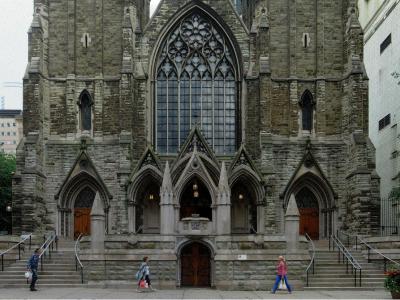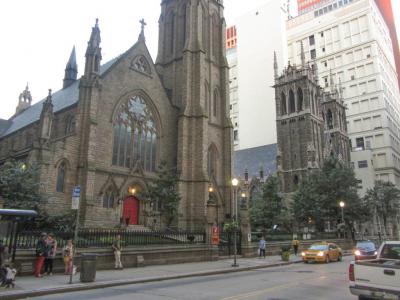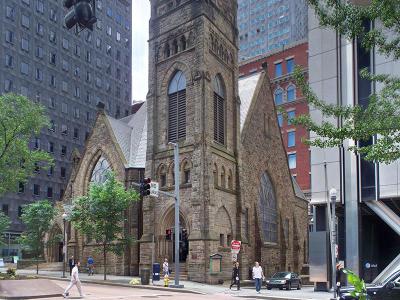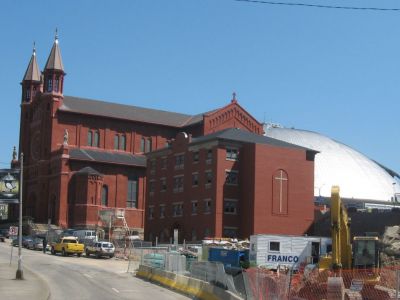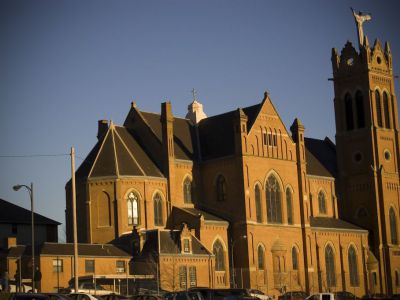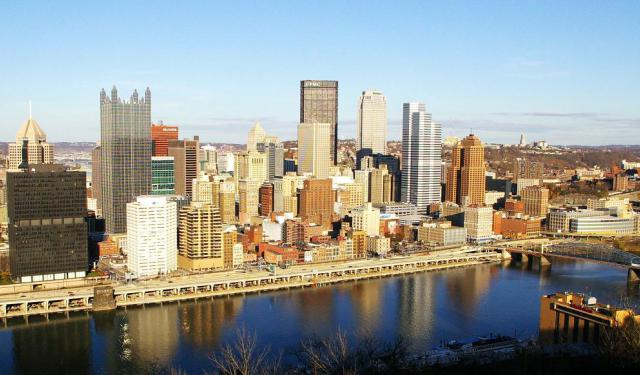
Pittsburgh's Historical Churches (Self Guided), Pittsburgh
Pittsburgh's storied landscape is interwoven with the resplendent charm of its historical churches. Apart from being testaments to the city's rich religious heritage and the enduring spirit of faith, these abodes of worship stand as venerable monuments, whose architectural splendor etched an indelible mark on Pittsburgh.
Foremost among them is the First Presbyterian Church. This awe-inspiring piece of Gothic Revival imparts a sense of reverence and tranquility with its majestic spires, intricate stonework, and beautiful rose window.
Another significant example of Pittsburgh's ecclesiastical architecture is the Trinity Episcopal Cathedral, a harmonious marriage of glorious facade and soaring arches, delicate woodwork, and stained glass windows.
The First English Evangelical Lutheran Church is one of the oldest Lutheran congregations in Pittsburgh; its venerable edifice is imbued with the elegance of Neo-Gothic style.
Nestled in the Polish Hill neighborhood, the Divine Mercy Parish, previously known as the Church of the Epiphany, is yet another important historical temple. Its resolute red brick façade symbolizes the indomitable spirit of Pittsburgh's Polish diaspora.
In the Hill District, an enclave resonating with historical significance, the St Benedict the Moor Church holds sway as an extraordinary emblem of Pittsburgh's African American community. As a steadfast guardian of spiritual solace and social justice, this church pays homage to its namesake, the revered African-born Catholic saint who was known for his piety and devotion.
Amid the wealth of historical treasures, these esteemed sanctuaries encapsulate the essence of Pittsburgh's spiritual scene, transcending time and inviting reverence from all who behold their grandeur. If you seek insights into the historical and social fabric of Pittsburgh, whilst interested in the architectural and cultural landmarks that reflect the city's religious diversity, this self-guided walk is for you.
Foremost among them is the First Presbyterian Church. This awe-inspiring piece of Gothic Revival imparts a sense of reverence and tranquility with its majestic spires, intricate stonework, and beautiful rose window.
Another significant example of Pittsburgh's ecclesiastical architecture is the Trinity Episcopal Cathedral, a harmonious marriage of glorious facade and soaring arches, delicate woodwork, and stained glass windows.
The First English Evangelical Lutheran Church is one of the oldest Lutheran congregations in Pittsburgh; its venerable edifice is imbued with the elegance of Neo-Gothic style.
Nestled in the Polish Hill neighborhood, the Divine Mercy Parish, previously known as the Church of the Epiphany, is yet another important historical temple. Its resolute red brick façade symbolizes the indomitable spirit of Pittsburgh's Polish diaspora.
In the Hill District, an enclave resonating with historical significance, the St Benedict the Moor Church holds sway as an extraordinary emblem of Pittsburgh's African American community. As a steadfast guardian of spiritual solace and social justice, this church pays homage to its namesake, the revered African-born Catholic saint who was known for his piety and devotion.
Amid the wealth of historical treasures, these esteemed sanctuaries encapsulate the essence of Pittsburgh's spiritual scene, transcending time and inviting reverence from all who behold their grandeur. If you seek insights into the historical and social fabric of Pittsburgh, whilst interested in the architectural and cultural landmarks that reflect the city's religious diversity, this self-guided walk is for you.
How it works: Download the app "GPSmyCity: Walks in 1K+ Cities" from Apple App Store or Google Play Store to your mobile phone or tablet. The app turns your mobile device into a personal tour guide and its built-in GPS navigation functions guide you from one tour stop to next. The app works offline, so no data plan is needed when traveling abroad.
Pittsburgh's Historical Churches Map
Guide Name: Pittsburgh's Historical Churches
Guide Location: USA » Pittsburgh (See other walking tours in Pittsburgh)
Guide Type: Self-guided Walking Tour (Sightseeing)
# of Attractions: 5
Tour Duration: 1 Hour(s)
Travel Distance: 1.4 Km or 0.9 Miles
Author: leticia
Sight(s) Featured in This Guide:
Guide Location: USA » Pittsburgh (See other walking tours in Pittsburgh)
Guide Type: Self-guided Walking Tour (Sightseeing)
# of Attractions: 5
Tour Duration: 1 Hour(s)
Travel Distance: 1.4 Km or 0.9 Miles
Author: leticia
Sight(s) Featured in This Guide:
- First Presbyterian Church of Pittsburgh
- Trinity Episcopal Cathedral
- First English Evangelical Lutheran Church
- Divine Mercy Parish (formerly known as Church of the Epiphany)
- St Benedict the Moor Church
1) First Presbyterian Church of Pittsburgh
The First Presbyterian Church is nestled among the high rises of downtown Pittsburgh. The Neo-Gothic designed church was built in 1905 by Theophilus P. Chandler Jr. It has 253 stained glass windows, 13 of which were painted by hand by Tiffany Studios. The church has a wooden ceiling and a pipe organ with 4,400 individual pipes in a Baroque-style casing.
Visitors are welcome to the church service on Sundays where they can worship while also admiring the interior architecture. Those who prefer to view the church's exterior still have plenty to admire.
Along with the building's facade, tourists can step next door to view the historic cemetery, which is located between the First Presbyterian Church and Trinity Episcopal Cathedral. The Trinity Burying Ground is the oldest cemetery in Pittsburgh. Some of the graves date to the 1800s, including that of congressperson James S. Stevenson.
Visitors are welcome to the church service on Sundays where they can worship while also admiring the interior architecture. Those who prefer to view the church's exterior still have plenty to admire.
Along with the building's facade, tourists can step next door to view the historic cemetery, which is located between the First Presbyterian Church and Trinity Episcopal Cathedral. The Trinity Burying Ground is the oldest cemetery in Pittsburgh. Some of the graves date to the 1800s, including that of congressperson James S. Stevenson.
2) Trinity Episcopal Cathedral
Trinity Cathedral serves as the main cathedral for the Episcopal Diocese of Pittsburgh. The current Gothic-style church, which is the third building to accommodate the congregation, was finished in 1872 on the location of an old hilltop cemetery. This spot, situated on a terrace overlooking the historic "point" where the Allegheny River and the Monongahela River meet to form the Ohio River, held significance for Native Americans as a burial site. Early settlers also utilized it as a cemetery, and the congregation erected its second church there in 1824.
Trinity Churchyard contains the oldest marked graves west of the Atlantic Seaboard, including those of Native American leaders, French, English, and American colonists. The initial Trinity Church was constructed two blocks to the west of this burial ground at the foot of the hill or terrace during the late 18th and early 19th centuries.
In 1824, Trinity relocated to its present location in the middle of the churchyard on the terrace, featuring what is considered the first Gothic-style structure in Western Pennsylvania. John Henry Hopkins oversaw the design and building of the cathedral, which included buttresses, a tower, pointed arches, and a vaulted ceiling. The new Trinity Cathedral was completed in 1872, standing as the tallest building in the city until the construction of the Allegheny County Courthouse in 1888.
Trinity Churchyard contains the oldest marked graves west of the Atlantic Seaboard, including those of Native American leaders, French, English, and American colonists. The initial Trinity Church was constructed two blocks to the west of this burial ground at the foot of the hill or terrace during the late 18th and early 19th centuries.
In 1824, Trinity relocated to its present location in the middle of the churchyard on the terrace, featuring what is considered the first Gothic-style structure in Western Pennsylvania. John Henry Hopkins oversaw the design and building of the cathedral, which included buttresses, a tower, pointed arches, and a vaulted ceiling. The new Trinity Cathedral was completed in 1872, standing as the tallest building in the city until the construction of the Allegheny County Courthouse in 1888.
3) First English Evangelical Lutheran Church
The First English Evangelical Lutheran Church (or First Lutheran Church in short) was founded in 1837 as the First English-speaking Lutheran church. The current church building was completed in 1888. The building is known for some beautiful pieces of ecclesiastical art, namely the mosaic of the Presentation above the altar, the tabernacle, the Good Shepherd window, and the free-standing altar.
For example, the Good Shepherd window in the north wall of the nave above the choir space came as a gift in 1898. This large window consists of more than 500 square feet of Tiffany Favrile glass. The image depicts in the center the Good Shepherd stands in the midst of his sheep, hands clasped and eyes toward heaven, interceding for his flock. The Good Shepherd are accompanied by two angels on each side, one holding the torch of faith together with the book of knowledge and the other holding a palm of victory in one hand and a crown of stars in the other.
If you are in the area, it is definitely worth paying the church a visit to see the beautiful arts in your own eyes.
For example, the Good Shepherd window in the north wall of the nave above the choir space came as a gift in 1898. This large window consists of more than 500 square feet of Tiffany Favrile glass. The image depicts in the center the Good Shepherd stands in the midst of his sheep, hands clasped and eyes toward heaven, interceding for his flock. The Good Shepherd are accompanied by two angels on each side, one holding the torch of faith together with the book of knowledge and the other holding a palm of victory in one hand and a crown of stars in the other.
If you are in the area, it is definitely worth paying the church a visit to see the beautiful arts in your own eyes.
4) Divine Mercy Parish (formerly known as Church of the Epiphany)
Divine Mercy Parish was formed by merging of the former parishioners of Church of the Epiphany and Saint Mary of Mercy. The present building on Washington Place was completed in 1902 when it was still Church of the Epiphany. The building was added to the List of Pittsburgh History and Landmarks Foundation Historic Landmarks in 1998.
The building is a red brick Romanesque structure with a byzantine architecture flavor. The beautiful stained glass windows were installed between 1903 and 1910. On one side of the windows, the images depicts stories from the New Testament; on the other side, the images told the stories of the Old Testament.
Marble for the sanctuary was imported from Italy. The marble canopy over the main altar contains the extraordinary Venetian mosaic tympanum of the Visit of the Magi, and on the upper arch the enameled mosaic of the Lamb of God.
Divine Mercy Parish is located in the heart of downtown Pittsburgh and welcomes visitors during its opening hours.
The building is a red brick Romanesque structure with a byzantine architecture flavor. The beautiful stained glass windows were installed between 1903 and 1910. On one side of the windows, the images depicts stories from the New Testament; on the other side, the images told the stories of the Old Testament.
Marble for the sanctuary was imported from Italy. The marble canopy over the main altar contains the extraordinary Venetian mosaic tympanum of the Visit of the Magi, and on the upper arch the enameled mosaic of the Lamb of God.
Divine Mercy Parish is located in the heart of downtown Pittsburgh and welcomes visitors during its opening hours.
5) St Benedict the Moor Church
Saint Benedict the Moor Catholic Church is a pivotal institution within the Black Catholic community in the Hill District neighborhood of Pittsburgh. This church, with its rich history and cultural significance, stands as a beacon of faith and heritage for African-American Catholics in the region.
Constructed in 1894, the building initially served as Holy Trinity Church before its suppression in 1958. In a notable transformation during the 1960s, Saint Benedict's parish, originally established in 1889, amalgamated with this church and two other parishes, marking a new chapter in its history. This merger not only expanded its congregation but also reinforced its role in the community.
A significant highlight of the church is the 18-foot tall statue of Saint Benedict the Moor, crafted by Frederick Charles Shrady, which was installed atop its tower in 1968. This statue not only enhances the architectural grandeur of the building but also symbolizes the parish's dedication to its patron saint, reflecting the enduring faith and resilience of the Black Catholic community.
The church's historical and cultural importance was officially recognized in 1998 when it was added to the List of Pittsburgh History and Landmarks Foundation Historic Landmarks. This designation underscores the building's architectural and social significance, preserving its legacy for future generations.
In a historic move in June 2020, Bishop David Zubik of Pittsburgh announced the designation of Saint Benedict the Moor Church as a personal parish for African-Americans. This formal recognition came after decades of the church serving informally as a central place of worship for the Black Catholic community. This decision affirms the church's role in nurturing the spiritual and social well-being of its congregation, ensuring that it remains a vital center for faith, culture, and community engagement in Pittsburgh.
Constructed in 1894, the building initially served as Holy Trinity Church before its suppression in 1958. In a notable transformation during the 1960s, Saint Benedict's parish, originally established in 1889, amalgamated with this church and two other parishes, marking a new chapter in its history. This merger not only expanded its congregation but also reinforced its role in the community.
A significant highlight of the church is the 18-foot tall statue of Saint Benedict the Moor, crafted by Frederick Charles Shrady, which was installed atop its tower in 1968. This statue not only enhances the architectural grandeur of the building but also symbolizes the parish's dedication to its patron saint, reflecting the enduring faith and resilience of the Black Catholic community.
The church's historical and cultural importance was officially recognized in 1998 when it was added to the List of Pittsburgh History and Landmarks Foundation Historic Landmarks. This designation underscores the building's architectural and social significance, preserving its legacy for future generations.
In a historic move in June 2020, Bishop David Zubik of Pittsburgh announced the designation of Saint Benedict the Moor Church as a personal parish for African-Americans. This formal recognition came after decades of the church serving informally as a central place of worship for the Black Catholic community. This decision affirms the church's role in nurturing the spiritual and social well-being of its congregation, ensuring that it remains a vital center for faith, culture, and community engagement in Pittsburgh.
Walking Tours in Pittsburgh, Pennsylvania
Create Your Own Walk in Pittsburgh
Creating your own self-guided walk in Pittsburgh is easy and fun. Choose the city attractions that you want to see and a walk route map will be created just for you. You can even set your hotel as the start point of the walk.
Mount Washington Walking Tour
Mount Washington is a hill on the southern banks of the Monongahela River and Ohio River. Due to its elevated position, the top of the hill offers a spectacular view of Downtown Pittsburgh below. The Mount is a prime tourist attraction in the city, and many photos and drawings of the Pittsburgh skyline have originated here.
If you want to see what Pittsburgh looks like from above, take this... view more
Tour Duration: 1 Hour(s)
Travel Distance: 1.8 Km or 1.1 Miles
If you want to see what Pittsburgh looks like from above, take this... view more
Tour Duration: 1 Hour(s)
Travel Distance: 1.8 Km or 1.1 Miles
Downtown Architectural Jewels
Pittsburgh's Downtown is laden with an array of stylish architectural gems. Scattered throughout the city's urban core, these landmarks, some of which date back as far as the 18th century, collectively evoke an air of grandeur and historical significance.
The Fort Pitt Blockhouse, an emblem of resilience and frontier spirit, is the oldest extant structure in Western Pennsylvania,... view more
Tour Duration: 2 Hour(s)
Travel Distance: 2.6 Km or 1.6 Miles
The Fort Pitt Blockhouse, an emblem of resilience and frontier spirit, is the oldest extant structure in Western Pennsylvania,... view more
Tour Duration: 2 Hour(s)
Travel Distance: 2.6 Km or 1.6 Miles
Oakland District Walking Tour
Welcome to Oakland, an academic and cultural center of Pittsburgh! Representing a harmonious blend of intellectual prowess, cultural marvels, and natural splendor, this captivating neighborhood brims with attractions to overlook which would be a terrible miss!
As a manifestation of the transformative power of knowledge and creativity, Oakland, in large part, owes its status to the 19th-century... view more
Tour Duration: 2 Hour(s)
Travel Distance: 2.8 Km or 1.7 Miles
As a manifestation of the transformative power of knowledge and creativity, Oakland, in large part, owes its status to the 19th-century... view more
Tour Duration: 2 Hour(s)
Travel Distance: 2.8 Km or 1.7 Miles
Pittsburgh Introduction Walking Tour
Pittsburgh is the second largest city in Pennsylvania. The metro area is also the largest in Appalachia, the Ohio Valley and one of the most populous in the country. It known colloquially as "Steel City" due to its mainstay as a leader in manufacturing steel and other important materials like glass and aluminum. Pittsburgh also holds an important place in the history of the United... view more
Tour Duration: 2 Hour(s)
Travel Distance: 3.2 Km or 2 Miles
Tour Duration: 2 Hour(s)
Travel Distance: 3.2 Km or 2 Miles
The Most Popular Cities
/ view all
